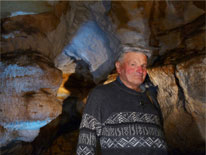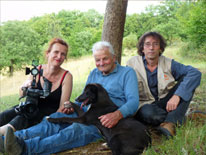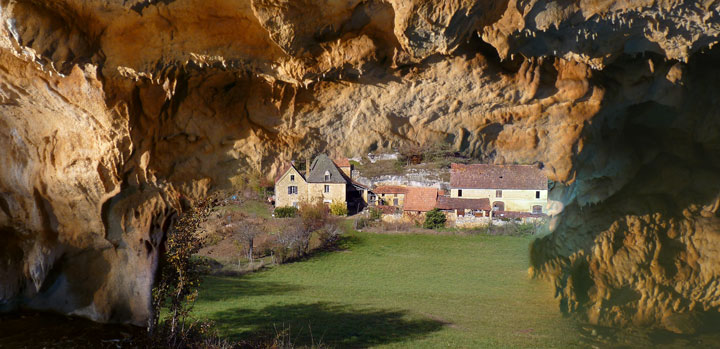|
Prehistory, animal skins, mammoth hunting, cave art…
how long ago that seems! … maybe because we’ve put it all to
the back of our minds. A long period of amnesia, since precious
little has been put down in writing to help jog our memories.
Of course there were the funny-shaped flints found while
ploughing the fields. We called them “thunderstones” and
went on ploughing… until strange-looking craniums began
to crack beneath our pickaxes. Not apes, men! ... but hardly
in God’s image, in our image. And there we were, off on a
voyage into Prehistory which started a hundred and fifty
years ago.
In the early days, digging for skeletons and flint tools
proved to be an extremely lucrative business – a veritable
treasure hunt which drew a large number of antique dealers
and researchers to the Périgord. It was the peasants who
formed the workforce as we started whirling back to our
origins.
It soon became obvious that the rock shelters had once
been refuges. Where there is life there is death - and a whole
array of stone and bone artefacts. But that was nothing
compared with the caves which, on the odd occasion, had
far more than skeletons to offer us: on their walls were
drawings, paintings, testimony to the imagination of our
famous ancestors, so different from us and now, all of a
sudden, so strangely familiar.
These caves are indeed few and far between, but
some were being discovered in the Périgord, in “peasant
country”. « The Reindeer Age », right there - just beneath
the cowshed! Wow! Propelled to the status of owners of
major prehistoric sites, the peasants became the guardians
of these precious sanctuaries. During the twentieth century
these farmers, who were in danger of extinction anyway,
handed over their responsibilities to the competent
authorities, more capable, in theory, of assuming the duties
and ensuring the safeguard of what were to become:
World Heritage Sites.
However, one of them has stood his ground in the
face of the authorities: he is the last of the owners and he
takes pride in showing you, personally, around his very own
Paleolithic painted cave. His name is Gilbert Pémendrant; he
was born on June 12, 1935 in his parents’ home in Meyrals,
near Les Eyzies in the Périgord Noir. A splendid farm, part
of which is troglodytic, built on that very same spot where
prehistoric man lived beneath the rock.
Gilbert, who has spent his life looking after his cows,
which are as beautiful as aurochs, didn’t find it hard to pick
up the thread where his ancestors had left off 20,000 years
ago. He began scrutinizing his cave and all the “pictures”
he had inherited: family portraits, “the hunt” and, already,
masterpieces of abstract art.
After chatting to some of the best prehistorians of
our time, who have been coming in steady numbers to
enumerate the wonders of Bernifal (over the last century
the number of pictures that have been registered has risen
from 36 to 130), Gilbert has become familiar with the exact
terms to be used when talking about these pictures from
“the Magdalenian” (“The Age of the Reindeer”). The little
groups of visitors who have managed to find Bernifal (“the
cave that isn’t on the map”) can listen to Gilbert, telling the
stories with his lovely Occitan accent - each time seemingly
“for the first time”. They must wend their way through the
cave in the dark but there’s always the stardust in Gilbert’s
eyes!
|
|
Gilbert loves his cave. He can find his way around with
his eyes closed, without damaging anything. It is a fact that
he and his family have kept everything just as it was the day
the site was found in 1898 by Abbé Breuil. The Pémendrants
have always been opposed to excavations, lighting and
arrangements in any shape or form. Their preservation
protocol has been their peasant instinct: protecting nature,
inside and out. Bernifal is indeed in good hands.
Like everybody else who has had the privilege of visiting
Bernifal, the first time I went there I fell in love with the place
and the way Gilbert has of sharing it with us. On that special
day out I found myself back in my wonderful childhood
days, with Louise and Albin, the grandparents I had chosen
for myself: two human beings who were self-sufficient and
didn’t have a car or a bathroom. Their accent, their delicacy,
even the way they had of not trusting anybody… it was all
there, intact, in Gilbert.
So I made a promise to myself: I would gain his
confidence. It took me many months - or rather, it gave me
a multitude of magical moments. I revelled in the hours we
spent together - when he talked about his farm, his cave…
when he told me his life story and I could sense the strong
and ever so simple bond he has with our distant past, our
roots. His politeness, his refinement, his honesty and his
dignity are a true delight; Gilbert is the perfect gentleman.
He embodies everything of the best in the Périgord and
following him around, as he quietly goes about his daily
tasks, gives meaning to this life on earth.
I for one am in need of friends like Gilbert who give me
the strength to carry on.
I have wanted to share this friendship, this gentleness,
with others - in a documentary. The portrait of the last
peasant-cum-prehistorian in the Périgord: his name is
Gilbert Pémendrant. Part of the film was shot in the dark but
everywhere there is sunshine, as we go up and down, from
the cowshed to the bison sanctuary and from where cave
bears wallowed back to Gilbert’s den where, tucked safely
away, he likes to read “L’Art des Cavernes”, the grand atlas
of Paleolithic decorated caves in France which stresses the
importance of Bernifal Cave:
• The cave where Abbé Breuil, who was to become
the “Pope of Prehistory”, made his first list of cave
paintings
• The least-known and at the same time the most
emblematic of its kind: paintings, engravings and
bas-reliefs can be observed from one end of the
cavity to the other
• One of the few caves to have remained exactly as it
was on the day it was found – absolutely undamaged
• One of the last caves where the visit is conducted by
the owner: a farmer, who is 75 years old.
This 52 minute film has background music interpreted
by a band of folk musicians from the Périgord; this brings
the joyfulness and the touch of nostalgia that you invariably
feel when you meet this amazing character.
Sophie Cattoire
auteur réalisateur
Translation into English : Valérie Saraben
|




